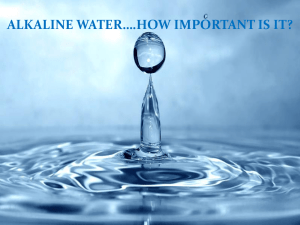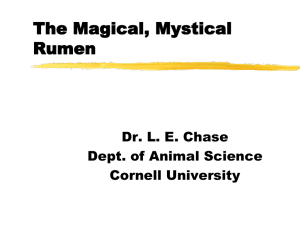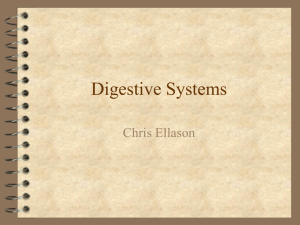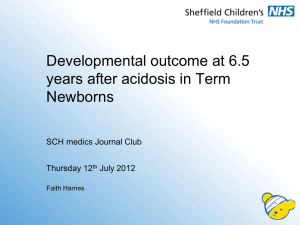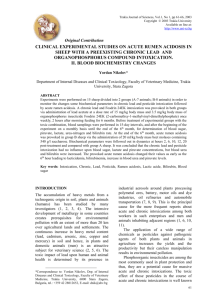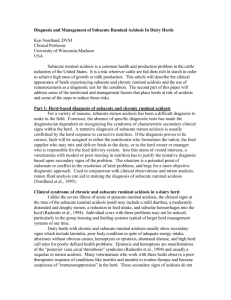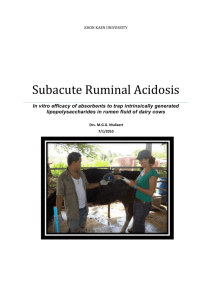Compound Feed and Rumen Acidosis
advertisement
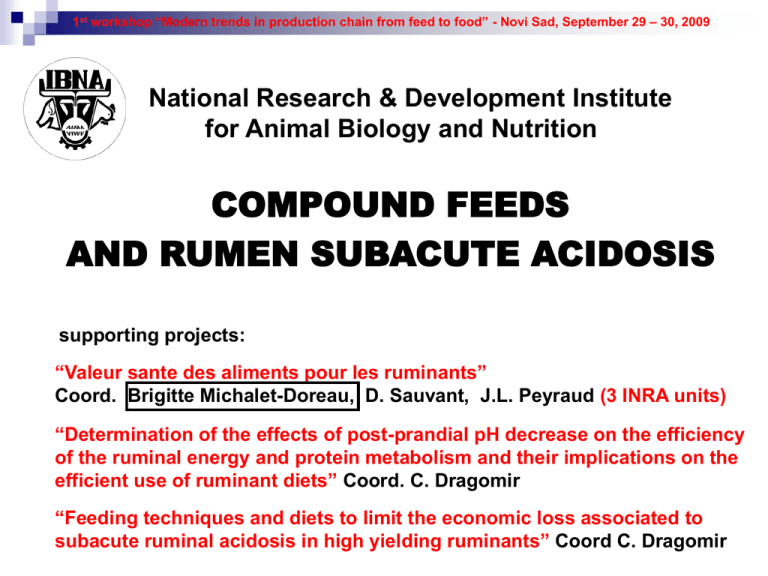
1st workshop “Modern trends in production chain from feed to food” - Novi Sad, September 29 – 30, 2009 National Research & Development Institute for Animal Biology and Nutrition COMPOUND FEEDS AND RUMEN SUBACUTE ACIDOSIS supporting projects: “Valeur sante des aliments pour les ruminants” Coord. Brigitte Michalet-Doreau, D. Sauvant, J.L. Peyraud (3 INRA units) “Determination of the effects of post-prandial pH decrease on the efficiency of the ruminal energy and protein metabolism and their implications on the efficient use of ruminant diets” Coord. C. Dragomir “Feeding techniques and diets to limit the economic loss associated to subacute ruminal acidosis in high yielding ruminants” Coord C. Dragomir 1st workshop “Modern trends in production chain from feed to food” - Novi Sad, September 29 – 30, 2009 CONTEXT animal husbandry – still a major occupation in Eastern Europe (EE) transition in EE = loss of - research directions, - research methods & procedures, - skilled people... ... overall = “loss of knowledge” e.g. subacute acidosis (SARA) is less known and feared in EE ! although less intensive poduction systems in EE (in average), still a major disorder + some EE favoring particularities: - quasi absence of computer assisted feeding parlors, - low level of compound feed processing, - frequent drought periods leading to higher conumption of CF - less frequent use or TMR, less awareness, etc. 1st workshop “Modern trends in production chain from feed to food” - Novi Sad, September 29 – 30, 2009 ACUTE versus SUBACUTE RUMEN ACIDOSIS - strong decrease of pH (following massive ingestion of rapidly degrabable carbohydrates in short time) -moderate decrease of pH (part of the time under physiological thresholds; difficult to avoid because of the need fot intensive feeding) - obvious clinical signs (in most severe cases, even death of the animals) - less obvious & unspecific clinical signs (irregularities and reduction of feed intake, panting, excessive salivation, diarrhea, kicking at the belly ...) - very low incidence (under focus for many years, can be prevented by respecting basic rules) - broad incidence (difficult to diagnose & low awareness – many animals in the risk categories are in various degrees of acidosis) Q for farmers: are you really sure your animals are not in ruminal acidosis ? 1st workshop “Modern trends in production chain from feed to food” - Novi Sad, September 29 – 30, 2009 BULK FORAGES vs CONCENTRATES DILEMA starting point: most animal production systems aims to fully valorize the production potential of the animals (+ market competition, “new” animals, etc.) BULK FORAGES CONCENTRATES - farm management difficulties: handling, shrinking, mixing, storing, removing manure... - less farm management problems (most farm managers would love diets with 100% concentrates) - lower feeding efficiency (many cases) - higher feeding efficiency (when no digestive / metabolic disorders occur) - higher satiety value (! early lactation cows) - lower satiety value –> higher ingestibility often, farm managers have to choose a concentrate-rich diet and that’s it ! 1st workshop “Modern trends in production chain from feed to food” - Novi Sad, September 29 – 30, 2009 COMPROMISE BETWEEN PERFORMANCES AND ACIDOSIS - need to increase dietary energy => higher ingestion / more concentrate / more starch / higher digestibility ... (push up) - need to decrease the risk of acidosis => more fiber, less (rapid) starch, etc. many factors influencing the two targets are conflicting (but not all of them) careless use of concentrates leads to effects that are opposite to the initial purpose Rumen acidosis associated problems: sudden death syndrome, reduced feed intake, reduced absorption, liver abscesses, grain bloat, clostridial infections... negative effects on animal health and performances (which translates in economical losses) often, the main objective of the intensive feeding of the ruminants is impaired optimisation is needed; although very common in nutrition, is more complicate when acidosis is involved Q: How far to push the animals feeding in some given conditions, without impairing the performances itselves through the onset of rumen acidosis? Q: How severe the acidosis may be, so the negative effects remain at local level (rumen), without significantly lowering animal performances, especially the overall feeding efficiency? not easy to answer: - rumen acidosis is a complex phenomena, which involves effects of organic acids production, ruminal pH, salivary flow, rate of passage, starch fermentation, feed intake, etc.) - consequently, its PREDICTION (alternative to diagnosis) is also difficult PREDICTION OF RUMEN ACIDOSIS - large amount of scientific data related to acidosis already published; articles normally described feeding situations quite accurately - rumen pH is a good overall indicator of rumen status: - reported in many articles (even not related to acidosis) * of course, feeding situations leading to pH decrease are concerned - important input in several rumen models - its influences on the rumen ecosystem are well documented - proposed thresholds, as limits for declaring acidosis (either acute or subacute), varies upon authors (5.0 ... 6.3) - important = biological significance (usually in vitro studies on pure cultures): inhibition of rumen functions such as the cellulolysis or the microbial proteisynthesis threshold-related parameters more interesting than average pH there is potential for linking dietary characteristics with rumen pH (as indicator of rumen acidosis) and therefore quantifying the risk of acidosis in a given feeding situation dietary characteristics that are usually shown in articles: - ingestion (sometimes time needed for ingestion / rumination) - concentrate / forage ratio - nature of the main dietary ingredients - presence of particular substances (buffers of buffer-like substances) - frequency of feeding - restrictions on intake (total / certain ingredients) - processing of concentrates (esp. rich in rapid energy) - proximal chemical analysis of feeds (+ quite often starch content) - apparent digestibility or rumen degradability of nutrients (! starch) - order of diet ingredients (for non-TMR) + duodenal flow of nutrients (+ its own factors of influence) + proximal analysis of milk (! milk fat) Why compound feeds & rumen acidosis in title? - processing: - ground (! granulometry) - steam-rolled - cracked - roasted - steam-flacked - degermed shelled - hull-less or not potential ways to influence (not always decrease !) the risk of acidosis onset (dietary side) - expanded - proportion & nature of energy ingredients + energy comes mostly through concentrates (usually compound feeds) highest determinant of the acidogenic potential of a diet - part of Feed to Food project - potential of collaborations with FINS & other research units dealing with animal nutrition - however, up to now, attempts to predict rumen pH = less successful - possible reason: lack of a good pH descriptor (Sauvant et al., 1999; Kolver and de Veth, 2002) 7 initial pH f inal pH pH initial slope f inal slope 6 area under pH 6 minimal pH duration where pH < 6 5 0 1 2 3 4 5 6 7 8 time (hours) time f or minimum pH common shape of post-prandial pH evolution in rumen why not average pH ? (most articles on rumen report average rumen pH) 6,8 6,6 6,4 6,2 6 5,8 5,6 5,4 00:00 06:00 12:00 18:00 00:00 6,8 6,6 6,4 6,2 6 5,8 5,6 5,4 00:00 06:00 average pH = 5,9 ... 6,1 12:00 18:00 00:00 why not threshold-related pH parameters? (first reported in 1979 ! & and quite often in the last decade) - high global correlations between threshold-related parameters and mean pH (-0,825 ... -0,978. N=219) and both highly related to PC1 => threshold-related parameters bring no supplementary information except biological significance and theu higher variability - truncation at 0 is a limitation for their use in statistical analysis (truncation occur when threshold value is lower than minimum pH) in a study on 219 diets, even for the highest of the studied thresholds (pH = 6.2), many of the corresponding values were equal to 0 (30% for t < pH6.2 and 15% for a < pH6.2) – Dragomir et. al, 2008 - non-normal distribution of threshold-related variables in the same study, area under pH 5.5, 5.8, 6.0 and 6.2 decreased asymptotically to 0 while mean pH became higher than pH threshold cautions should be taken when using linear models for statistical analyses that include threshold-related variables 8 6 4 2 0 5.5 6.0 6.5 7.0 8 pHmoyr mean pH (0-8 hrs) a < pH 6.2 t < pH 6.2 asymptotic evolution 6 4 2 truncation at 0 0 5.5 6.0 6.5 pHmoyr mean pH (0-8 hrs) 7.0 anyway, area undetr threshold much better than period of time under threshold 8 7 6 t < pH 6.2 5 period = length of acidosis area = intensity of acidosis 4 3 2 1 N = 219, Dragomir et. al, 2008 0 0 1 2 3 a < pH 6.2 4 5 6 why not alternative pH parameters? (some of them used as concepts or rarely reported also elsewhere but no systematic approach yet) candidates: - coeficients of a third degree polynomial equation modelling the post-prandial evolution of pH (219 practical situation fairly fitted this equation) pHt = at3 + bt2 + ct + d, where “t” is expressed in hours - initial and final slopes of pH post-prandial evolution (obtained by replacing t e.g. 0 or 8 hrs, respectively, in the first derivatives of the polynomial equations) - t min, time when pH reaches its minimum (obtained by choosing one of the two roots of derivative depending on the sign of the first derivative. In the cases when tmin is outside the studied area it was can be considered equal to the studied period) - pH0-min; pH0-8 and pHs.d. (but based on individual measures – first two or no direction of variability – third one; they are just giving an image) - all of the above candidates = less related to PC1 (but highly related to PC2-4) - they carry supplementary info that can be added to the mean pH 1st workshop “Modern trends in production chain from feed to food” - Novi Sad, September 29 – 30, 2009 7 pH 6,5 6 “level” (average pH & similar) 5,5 by PC2 by PC1 “slope” 5 7 pH 6,5 6 5,5 “deepness” by PC3 5 “lag-time” hours by PC4 various types of pH curves identified by PCA of the data (219 entries in database * 17 points; Dragomir et al, 2008) hours 1st workshop “Modern trends in production chain from feed to food” - Novi Sad, September 29 – 30, 2009 PRACTICAL IMPLICATIONS feed intake FEED ADDITIVES (buffers, yeasts, bacterial cultures, ...) byproducts meal frequency no of ingredients availability of carbohydrates energy density of the diet rate of carbohydrates availability temporary restriction on ingesta C:F ratio COMPOUND FEEDS PROCESSING e NDF roughage level and nature defaunating strategies TMR & sorting osmotic pressure in rumen protein ingredients (releasing ammonia) + proper set of rumen pH descriptors equations (models?) allowing to predict acidogeneity of a diet (rather feding situation) from dietary characteristics



